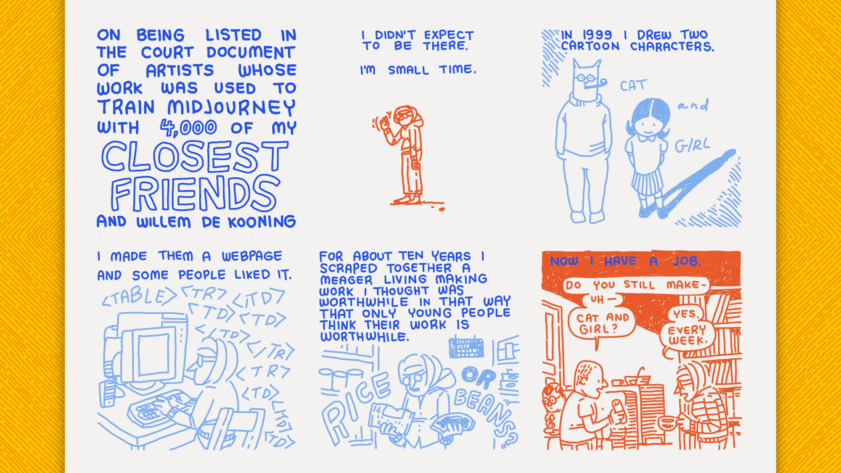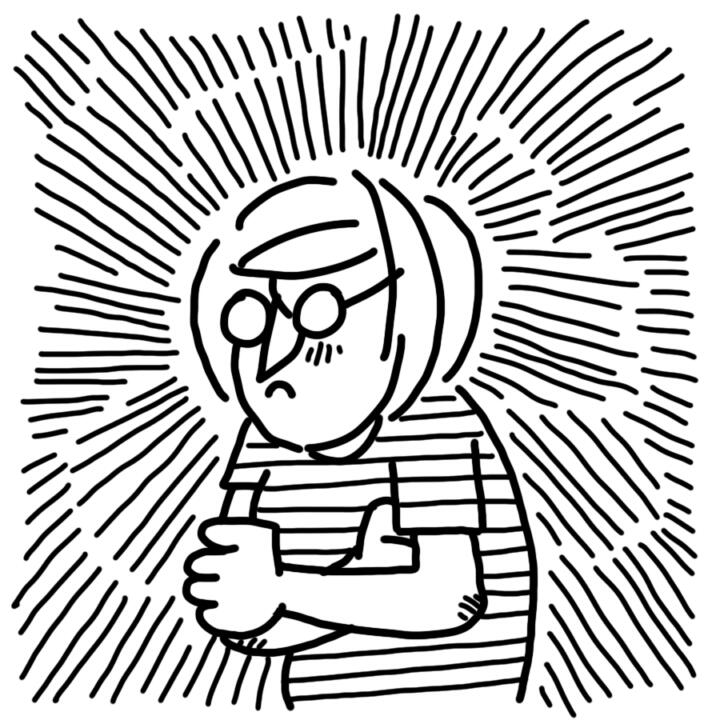Hi,
I’m Gabriel Hongsdusit, The Markup’s visual designer. In my role as an illustrator and art director, I create, find, and commission images for our stories on technology. I put a lot of thought into how illustration can hold AI accountable.
This week, I spoke with Dorothy Gambrell, who earlier this year drew a comic called “4,000 of My Closest Friends” about finding out her work was part of a dataset used to train Midjourney. It’s a profound meditation on the struggles of being an independent artist. Gambrell’s web comic, Cat and Girl, started in 1999 and has been running for close to 25 years now.
I spoke with her about taxpayers and oxen, why it’s important for artists to have a website, and how she came up with “4000’s” heartbreaking ending. Our conversation has been edited for brevity and clarity.
Gabriel: How did you discover that your work was used to train MidJourney?
Dorothy: A link to the court document was posted tagging a bunch of old time webcomics people, so I made what I thought would be a cursory check and it was… not cursory. And the idea of this just took up space in my head. How putting anything online is relinquishing control of it, how our main avenue of communication requires that our communication be available for the already-wealthy to monetize. It called up how what we thought was the promise of the web 25 years ago has really curdled, and how inescapable that curdled world now is.
Gabriel: One of the most striking points that you touched on is that it’s nearly impossible to get your work out without relying on the for-profit companies that depend on us making free content for their platforms. At the same time, illustration and art exist for an audience. What’s your advice to the artist looking to get their work out and not take part in these exploitative systems?
Dorothy: There is no good advice because there’s no good solution. You can have a website. You should have a website. But people really do not want to go to websites. So go to the platforms where the people are! But – also have a website. When the platforms inevitably fail, don’t let them take years of your work down with them.
Gabriel: You mention you started this web comic in 1999. The Internet has changed a lot since then. How has being an independent artist changed given…the Internet?
Dorothy: For every medium there is the first generation of people who come in and look to create and communicate and explore the limits of possibilities without any forethought of monetization. You know, real weirdos. That was when I came into webcomics. And as the medium matured, and by matured I mean people figured out how to make money, the people it attracted changed. Not that the new people were mercenary, but maybe a little more practical.
Internet users in 1999 were seeking out things to read and see. We had the internet, we wanted it to entertain us, and there just wasn’t much there. So it was really exciting to find someone’s comics! People were really excited to find your comics! And then the internet filled up, and it was hard to get anyone’s attention, because there were so many other things to see and do. And now… there are so many things, but it feels like there’s nothing. We’re all content, and content is just an infinite slog. I feel that way as a reader, too. Somehow removing the small effort of searching something out or entering a url has made everything we see feel equally worthless.
Gabriel: What has been the reception to the comic?
Dorothy: I’ve heard from people publicly. I think this whole conversation is public, and needs to be public. I don’t think my name is on that list because my style is in demand – a lot of early web cartoonists just had the “right” timing where we put a large volume of images out, for years, for free. And I sure hope AI copying my style is not going to make a lot of money for AI because I have never made a lot of money with it.
I think the most interesting conversation is just figuring out if we’re looking at the destruction of entire classes of creative livelihoods or the next snake oil tech bubble. Or both. It could also be both.
Gabriel: So much of the discussion around generative AI and illustration is about technology encroaching upon illustration. But I’m also interested in the inverse of that relationship. Do you think illustration and comic art can influence how we think about AI?
Dorothy: So it’s Plato’s cave, right? Eons ago we lived our messy, imperfect, edge-case lives in a universe we couldn’t understand. And then we got numbers, and the numbers were so much help. How many oxen does the tax collector say we have? Five? Is the baby ox a whole ox? Is the ox dead? Is the ox near death? Five is not a perfect description, but the numbers help us distinguish our herd versus the neighbors. They help the state understand the limits of livestock in our area. Five is good, it helps us understand, and before you know it we’re calculating the heliocentric solar system. But somewhere along the way, instead of the numbers being the abstract shadows of our gross messy lives, the numbers became the real thing. And we became the shadows. And the parts of the shadows that didn’t exactly reflect the numbers became problems.
I hope that, with AI mastering the parts of illustration and image that its programmers consider important or skilled, that we see just what that leaves out. That we see the parts the numbers don’t, and can realize how real and how important those parts are.
Gabriel: A question I think about all the time is how to visualize technology and AI without using robots all the time. I loved how your comic ended; I thought it was so effective to visualize AI as this predatory mouth that eats you. How did you come up with that?
Dorothy: Because it’s eating us! It’s taking what we’ve made – all of us, what we have left, this diminished digital Library of Alexandria – subtracting the intentionality that made it human and using it to make money. In the way that money, these numbers whose only value is in our agreeing they have value, has decided to maximize this value by investing in buying houses and selling ads and exploring oil fields. The money is also eating us. The money is eating affordable housing and journalism and an inhabitable earth to make the gray goo of more money. And once everything has been eaten, what’s left?
You can read Gambrell’s web comic, Cat and Girl, on her website.
Thanks for reading.
Sincerely,
Gabriel Hongsdusit
Visual Designer
The Markup





